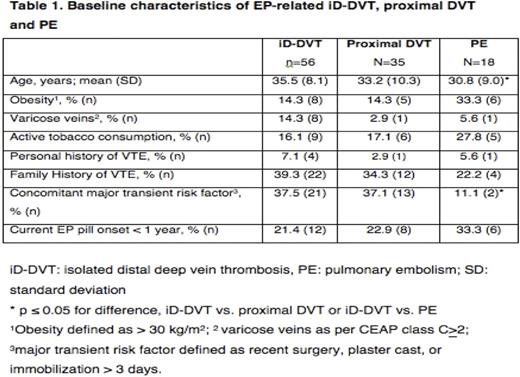Abstract
Background: Isolated distal deep-vein thrombosis (iD-DVT), defined as infra-popliteal DVT without pulmonary embolism (PE), is the most frequent presentation of venous thromboembolism (VTE). iD-DVT generally shares the same triggering risks factors as proximal DVT. In women of childbearing age, a frequent triggering risk factor is use of estrogen/progesterone (EP) birth control pills. However, data on the epidemiology and longterm outcomes of EP-associated iD-DVT are lacking.
Objectives: To assess the epidemiology and long-term outcomes of EP-associated iD-DVT.
Methods: Using data from the OPTIMEV multicentre cohort study of patients with objectively confirmed VTE (all suspected DVT was assessed with standardized bilateral whole leg ultrasound), in women <50 years old and without cancer: i) the proportion of EP-related iD-DVT among women with iD-DVT and among women with EP-related VTE (iD-DVT, proximal DVT or PE); ii) clinical characteristics of EP-related iD-DVT; iii) the attributable risk of EP on the occurrence of VTE (compared with controls: i.e., OPTIMEV women <50 years old and without VTE and cancer, nested case control study); iv) the 3-year incidence of death, bleeding and VTE recurrence after stopping anticoagulants.
Results: 283 women fulfilled our study criteria; of these, 56 had EP-related iD-DVT, which represented 37.8% of all iD-DVT and 51.4% of EP-related VTE. Table 1 shows that demographics and clinical characteristics did not markedly differ between EP-related iD-DVT vs. EP-related proximal DVT. The attributable risk of EP for the occurrence of iD-DVT was 21%, for proximal DVT was 17%, and for PE was 9%. Among women with EP-related iD-DVT, 97.7% were treated with therapeutic anticoagulation for a median duration of 90 days, and there were no major bleeds on treatment. At 3 years follow-up, all women were alive and only one experienced a VTE recurrence (a superficial vein thrombosis) after stopping anticoagulants (recurrence incidence = 0.8% per person-year (PY)). Similar results were found in patients with EP-related proximal DVT and EP-related PE (VTE recurrence incidence 1.5% per PY and 0% per PY, respectively; no deaths and no major bleeds in both groups).
Conclusions: iD-DVT is the most frequent clinical presentation of EP-related VTE. Clinical characteristics of patients with EP-related distal DVT and EP-related proximal DVT are very similar. The prognosis of EP-related iD-DVT is good, with a very low incidence of adverse outcomes in the long-term.
No relevant conflicts of interest to declare.
Author notes
Asterisk with author names denotes non-ASH members.


This feature is available to Subscribers Only
Sign In or Create an Account Close Modal